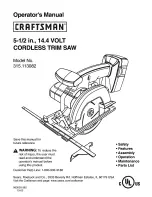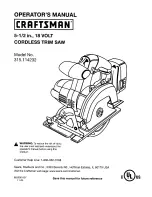
3
ENGLISH
4.
Do not abuse the cord. Never use the cord for
carrying, pulling or unplugging the power tool.
Keep cord away from heat, oil, sharp edges
or moving parts.
Damaged or entangled cords
increase the risk of electric shock.
5.
When operating a power tool outdoors, use an
extension cord suitable for outdoor use.
Use of
a cord suitable for outdoor use reduces the risk of
electric shock.
6.
If operating a power tool in a damp location
is unavoidable, use a residual current device
(RCD) protected supply.
Use of an RCD reduces
the risk of electric shock.
7.
Use of power supply via an RCD with a rated
residual current of 30 mA or less is always
recommended.
Personal Safety
1.
Stay alert, watch what you are doing and use
common sense when operating a power tool.
Do not use a power tool while you are tired or
under the inluence of drugs, alcohol or med
-
ication.
A moment of inattention while operating
power tools may result in serious personal injury.
2.
Use personal protective equipment. Always
wear eye protection.
Protective equipment such
as a dust mask, non-skid safety shoes, hard hat or
hearing protection used for appropriate conditions
will reduce personal injuries.
3.
Prevent unintentional starting. Ensure the
switch is in the off-position before connecting
to power source and/or battery pack, picking
up or carrying the tool.
Carrying power tools with
your inger on the switch or energising power tools
that have the switch on invites accidents.
4.
Remove any adjusting key or wrench before
turning the power tool on.
A wrench or a key left
attached to a rotating part of the power tool may
result in personal injury.
5.
Do not overreach. Keep proper footing and
balance at all times.
This enables better control
of the power tool in unexpected situations.
6.
Dress properly. Do not wear loose clothing or
jewellery. Keep your hair and clothing away
from moving parts.
Loose clothes, jewellery or
long hair can be caught in moving parts.
7.
If devices are provided for the connection of
dust extraction and collection facilities, ensure
these are connected and properly used.
Use of
dust collection can reduce dust-related hazards.
8.
Do not let familiarity gained from frequent use
of tools allow you to become complacent and
ignore tool safety principles.
A careless action
can cause severe injury within a fraction of a
second.
Power tool use and care
1.
Do not force the power tool. Use the correct
power tool for your application.
The correct
power tool will do the job better and safer at the
rate for which it was designed.
2.
Do not use the power tool if the switch does
not turn it on and off.
Any power tool that cannot
be controlled with the switch is dangerous and
must be repaired.
3.
Disconnect the plug from the power source
and/or remove the battery pack, if detachable,
from the power tool before making any adjust
-
ments, changing accessories, or storing power
tools.
Such preventive safety measures reduce
the risk of starting the power tool accidentally.
4.
Store idle power tools out of the reach of chil-
dren and do not allow persons unfamiliar with
the power tool or these instructions to operate
the power tool.
Power tools are dangerous in the
hands of untrained users.
5.
Maintain power tools and accessories. Check
for misalignment or binding of moving parts,
breakage of parts and any other condition that
may affect the power tool’s operation. If dam-
aged, have the power tool repaired before use.
Many accidents are caused by poorly maintained
power tools.
6.
Keep cutting tools sharp and clean.
Properly
maintained cutting tools with sharp cutting edges
are less likely to bind and are easier to control.
7.
Use the power tool, accessories and tool bits
etc. in accordance with these instructions, tak-
ing into account the working conditions and
the work to be performed.
Use of the power tool
for operations different from those intended could
result in a hazardous situation.
8.
Keep handles and grasping surfaces dry,
clean and free from oil and grease.
Slippery
handles and grasping surfaces do not allow for
safe handling and control of the tool in unexpected
situations.
Service
1.
Have your power tool serviced by a qualiied
repair person using only identical replacement
parts.
This will ensure that the safety of the power
tool is maintained.
2.
Follow instruction for lubricating and chang-
ing accessories.
Cut-off machine safety warnings
1.
Position yourself and bystanders away from
the plane of the rotating wheel.
The guard helps
to protect the operator from broken wheel frag-
ments and accidental contact with wheel.
2.
Use only bonded reinforced cut-off wheels for
your power tool.
Just because an accessory can
be attached to your power tool, it does not assure
safe operation.
3.
The rated speed of the accessory must be at
least equal to the maximum speed marked on
the power tool.
Accessories running faster than
their rated speed can break and ly apart.
4.
Wheels must be used only for recommended
applications. For example: do not grind with
the side of a cut-off wheel.
Abrasive cut-off
wheels are intended for peripheral grinding, side
forces applied to these wheels may cause them to
shatter.
5.
Always use undamaged wheel langes that are
of correct diameter for your selected wheel.
Proper wheel langes support the wheel thus
reducing the possibility of wheel breakage.






























